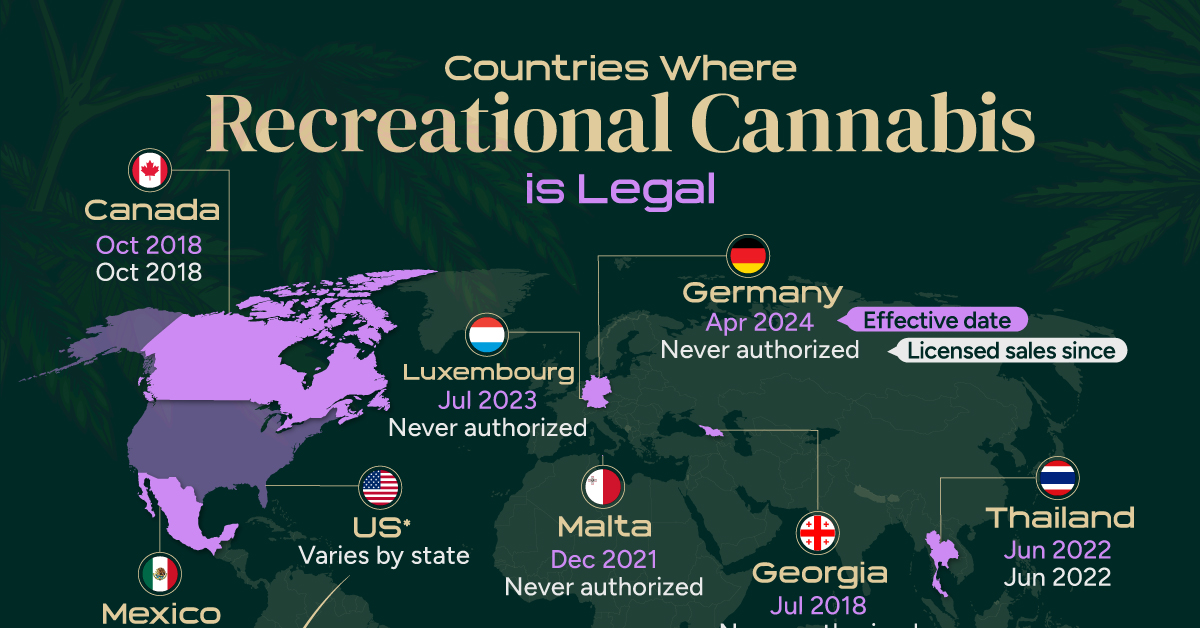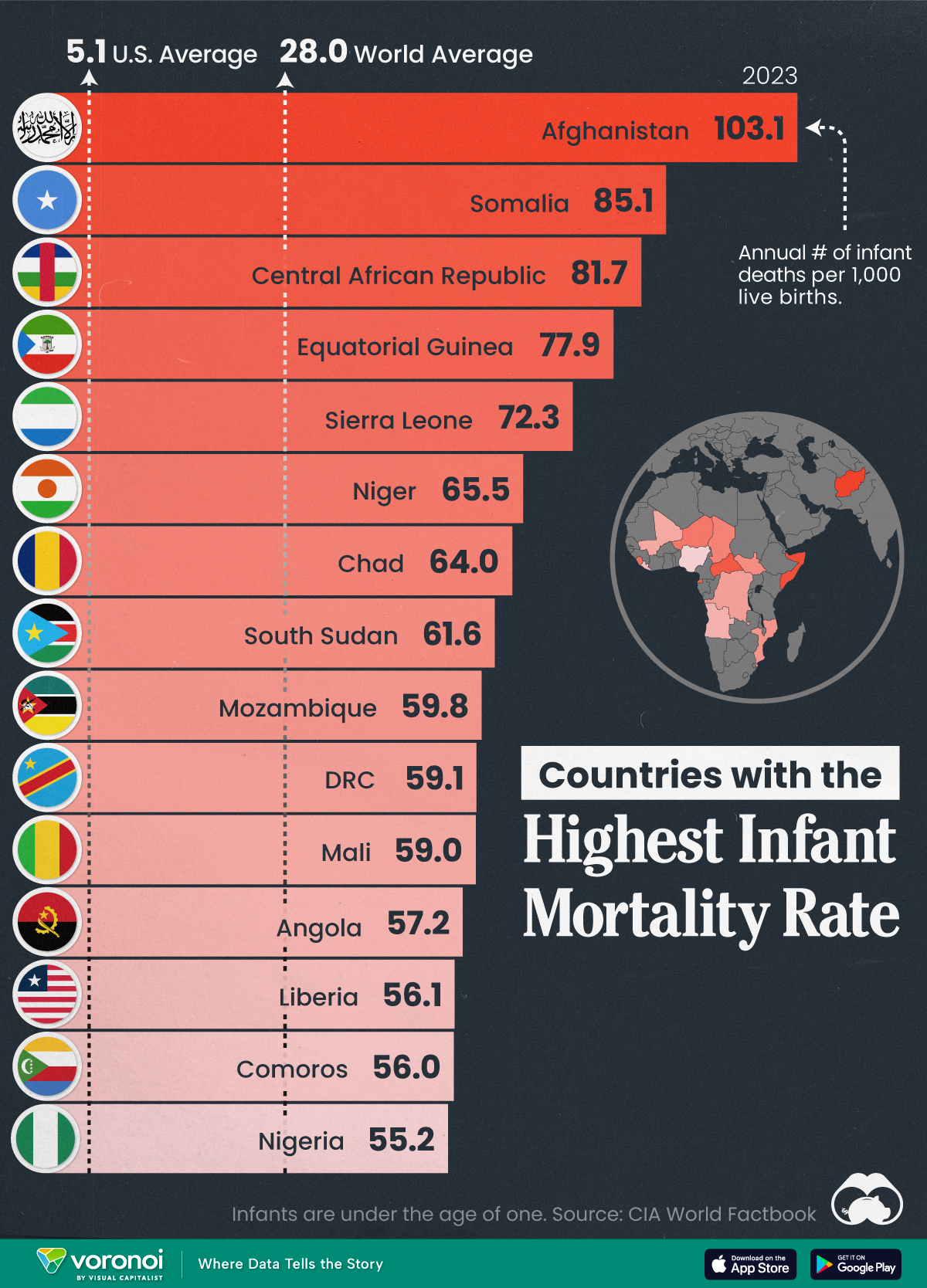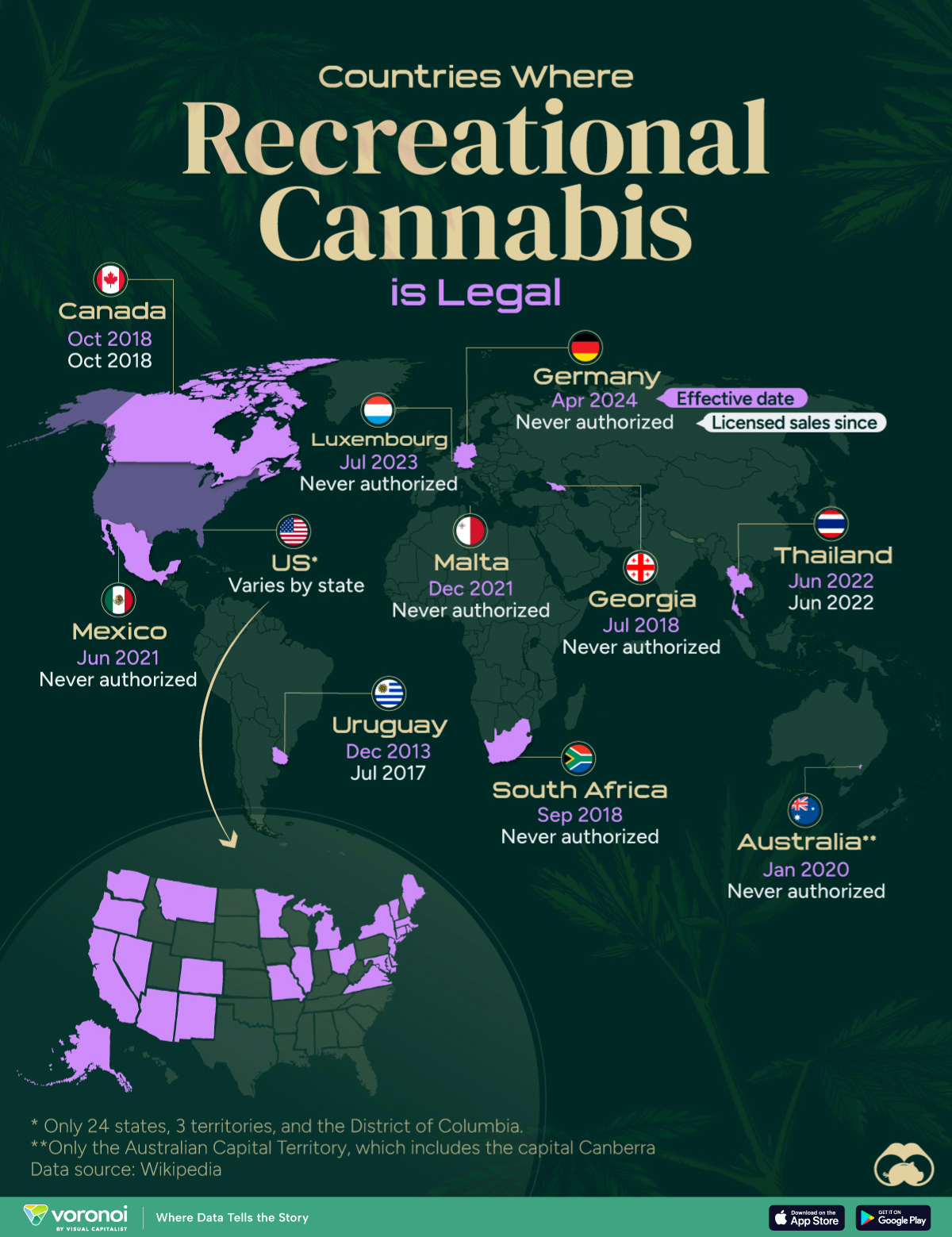Healthcare
Which Countries Have the Highest Infant Mortality Rates?
![]() See this visualization first on the Voronoi app.
See this visualization first on the Voronoi app.
Which Countries Have the Highest Infant Mortality Rates?
This was originally posted on our Voronoi app. Download the app for free on iOS or Android and discover incredible data-driven charts from a variety of trusted sources.
We visualized the top 15 countries with the highest infant mortality rates, according to 2023 estimates from the CIA World Factbook. It is measured as the number of infant deaths under the age of one, per 1,000 live births in a given year.
Infant mortality rates are generally regarded as the barometer of an overall population’s health. A higher rate indicates unmet needs of a population, especially with regards to food availability and sanitation.
Ranked: Countries With the Highest Infant Mortality Rates
Afghanistan currently has the highest infant mortality rate in the world at 103 deaths per 1,000 babies born. Decades of conflict have pushed the country to the brink and a prolonged drought since 2021 has made food more scarce.
| Rank | Country | Region | Infant Mortality Rate (2023) |
|---|---|---|---|
| 1 | 🇦🇫 Afghanistan | Asia | 103.1 |
| 2 | 🇸🇴 Somalia | Africa | 85.1 |
| 3 | 🇨🇫 Central African Republic | Africa | 81.7 |
| 4 | 🇬🇶 Equatorial Guinea | Africa | 77.9 |
| 5 | 🇸🇱 Sierra Leone | Africa | 72.3 |
| 6 | 🇳🇪 Niger | Africa | 65.5 |
| 7 | 🇹🇩 Chad | Africa | 64.0 |
| 8 | 🇸🇸 South Sudan | Africa | 61.6 |
| 9 | 🇲🇿 Mozambique | Africa | 59.8 |
| 10 | 🇨🇩 DRC | Africa | 59.1 |
| 11 | 🇲🇱 Mali | Africa | 59.0 |
| 12 | 🇦🇴 Angola | Africa | 57.2 |
| 13 | 🇱🇷 Liberia | Africa | 56.1 |
| 14 | 🇰🇲 Comoros | Africa | 56.0 |
| 15 | 🇳🇬 Nigeria | Africa | 55.2 |
| N/A | 🌐 World | World | 28.0 |
Meanwhile, the other 14 countries on this list are all from Sub-Saharan Africa. Some of them are also experiencing civil unrest, a breakdown of state machinery, and high undernourishment rates.
While this is concerning, Africa’s infant mortality rate as a whole has improved tremendously in the last seven decades. Between 1950–2024, the continent’s average fell 73% to 41 deaths per 1,000 births.
Expansion of healthcare, improving nutrition, access to clean drinking water, and mass immunization programs are some of the reasons behind this massive decline.
Estimates assume Africa’s infant mortality rate will improve further to 25 per 1,000 live births by 2050—which is roughly the same as Asia today.
Cannabis
Mapped: Countries Where Recreational Cannabis is Legal
In total, only nine countries have fully legalized recreational cannabis use.

Countries Where Recreational Cannabis is Legal
This was originally posted on our Voronoi app. Download the app for free on iOS or Android and discover incredible data-driven charts from a variety of trusted sources.
In 2024, Germany became the third European Union country to legalize cannabis for personal use, following Malta and Luxembourg.
Here, we map the countries where recreational cannabis use is allowed as of April 2024, based on data from Wikipedia.
Limited to Few Countries
In total, only nine countries have legalized recreational cannabis use nationwide. However, just a few of them have licensed sales.
| Country | Effective date | Licensed sales since |
|---|---|---|
| 🇺🇾 Uruguay | December 2013 | July 2017 |
| 🇬🇪 Georgia | 30 July 2018 | Never authorized |
| 🇿🇦 South Africa | 18 September 2018 | Never authorized |
| 🇨🇦 Canada | 17 October 2018 | 17 October 2018 |
| 🇲🇽 Mexico | 28 June 2021 | Never authorized |
| 🇲🇹 Malta | 14 December 2021 | Never authorized |
| 🇹🇭 Thailand | 9 June 2022 | 9 June 2022 |
| 🇱🇺 Luxembourg | 21 July 2023 | Never authorized |
| 🇩🇪 Germany | 1 April 2024 | Never authorized |
| 🇺🇸 U.S. | Varies by state | Varies by state |
| 🇦🇺 Australia | Varies by jurisdiction | Never authorized |
At the federal level, cannabis is still considered an illegal substance in the United States. That said, individual states do have the right to determine their laws around cannabis sales and usage. Currently, cannabis is allowed in 24 states, 3 territories, and the District of Columbia.
Interestingly, the oldest legal text concerning cannabis dates back to the 1600s—when the colony of Virginia required every farm to grow and produce hemp.
Since then, cannabis use was fairly widespread until the 1930s when the Marihuana Tax Act was enforced, prohibiting marijuana federally but still technically allowing for medical use.
Today, the U.S. cannabis market is a $30 billion business. By the end of the decade, that number is expected to be anywhere from $58 billion to as much as $72 billion.
Similar to the U.S., Australia does not allow the use at the national level, but cannabis can be used legally in the Australian Capital Territory, which includes the capital Canberra.
-

 Cannabis5 days ago
Cannabis5 days agoMapped: Countries Where Recreational Cannabis is Legal
-

 Technology2 weeks ago
Technology2 weeks agoMapped: The Number of AI Startups By Country
-

 Healthcare2 weeks ago
Healthcare2 weeks agoLife Expectancy by Region (1950-2050F)
-

 Markets2 weeks ago
Markets2 weeks agoThe Growth of a $1,000 Equity Investment, by Stock Market
-

 Markets2 weeks ago
Markets2 weeks agoMapped: Europe’s GDP Per Capita, by Country
-

 Money1 week ago
Money1 week agoCharted: What Frustrates Americans About the Tax System
-

 Technology1 week ago
Technology1 week agoCountries With the Highest Rates of Crypto Ownership
-

 Mining1 week ago
Mining1 week agoWhere the World’s Aluminum is Smelted, by Country















